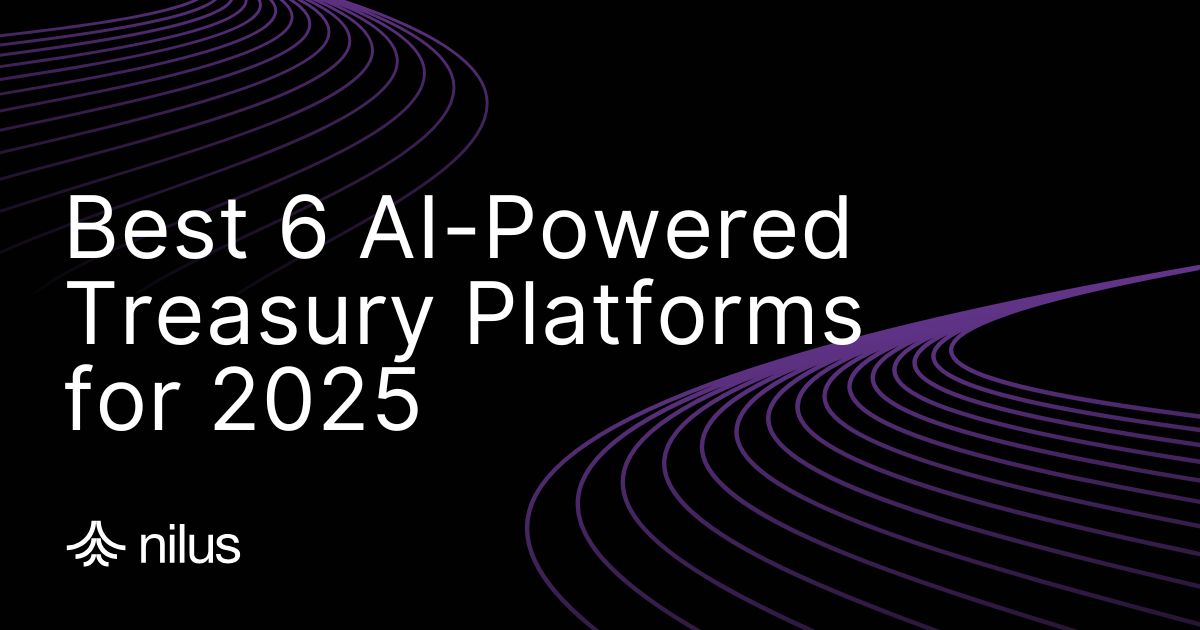NILUS GLOSSARY
Autonomous Finance Agents

Imagine your treasury desk as a living organism: continuously sensing market flows, adapting to unseen risks, and autonomously adjusting your cash, collateral, and commitments to keep the enterprise in balance. That is the promise of what we now call Autonomous Finance Agents. And, if you’re a finance or treasury professional, you’ll want to know how they work, sooner rather than later. Let’s break it down.
What Are Autonomous Finance Agents?
In plain English, Autonomous Finance Agents are AI-driven systems embedded in finance and treasury ecosystems that don’t just follow fixed rules, they also make decisions. These systems can perceive, reason, decide, and act, often without human intervention.
More formally, within the broader concept of autonomous finance (where financial processes are self-learning and self-managing), these agents are the operational actors. They differ from traditional automation in that they can:
- Learn and adapt from live data, instead of simply executing static workflows.
- Make and carry out decisions, such as initiating payments, reallocating liquidity, or escalating exceptions.
- Operate across finance and treasury domains in real time.
Think of these autonomous agents as digital colleagues. They’re tireless, data-literate partners that monitor, model, and move capital in ways that align with your financial strategy.
Why Autonomous Finance Agents Matter in Treasury and Finance
- Speed and scale. Human teams can’t manually monitor every transaction or exposure around the clock. Autonomous agents can.
- Move from reactive to proactive. Instead of finding a variance after month-end, your system detects a counterparty anomaly and reallocates funds before penalties hit.
- Control with fewer resources. Properly configured agents offer enhanced visibility, responsiveness, and auditability without an increased headcount.
- Strategic flexibility. Adaptive agents help finance operate in sync with the business, shifting liquidity, optimizing hedges, and adjusting funding in real time.
For CFOs and treasurers, this is a shift from asking “Can we automate this?” to asking “Which agents should we use to help us make better, faster financial decisions?”
{{cta}}
Autonomous Finance Agents: Core Characteristics and Capabilities
Autonomous finance agents typically exhibit five defining traits:
- Autonomy. They act within guardrails, not just on command.
- Adaptivity and learning. Behavior evolves with data and context.
- Goal-orientation. They pursue objectives (minimize idle cash, detect fraud) rather than follow linear scripts.
- Cross-system integration. They connect ERPs, banks, payment rails, and risk engines.
- Governance and auditability. Because they act independently, traceability and human oversight are essential.
Autonomous Finance Agents: Types and Use Cases
Autonomous finance agents already appear in several domains:
- Liquidity orchestration agents monitor cash positions across entities, predict surpluses or deficits, and trigger transfers or short-term investments.
- Payment routing agents choose the most efficient rail, currency, and timing to minimize cost and maximize reliability.
- Reconciliation and exception agents continuously match transactions and resolve anomalies, escalating only when human judgment is needed.
- Compliance and control agents track regulatory thresholds, identify fraud signals, and execute pre-emptive holds or adjustments.
- Insight and reporting agents generate dashboards, narratives, and recommendations that guide the next decision, not just summarize the data.
Moving From Automation to Autonomy
Legacy automation follows a playbook:
If invoice > $X, send for approval. When due date arrives, initiate payment.
Autonomous agents, however, observe, learn, and decide on their own:
We have surplus liquidity in region A and a shortfall in B. Route via rail C, hedge D, and execute before cutoff.
It’s a shift from automating known tasks to intelligently optimizing for what’s uncertain.
Where Finance Goes Next
Autonomous Finance Agents mark a structural shift in how finance and treasury operate, moving from control through human checkpoints to control through governed systems. The aim is not to replace human teams, but to elevate them, freeing people from manual cycles so they can focus on strategy, interpretation, and oversight.
As finance becomes more autonomous, the real challenge isn’t building the technology, it’s building trust. Teams need confidence in their data, in the rules that guide each agent, and in how people and systems make decisions together. What matters most isn’t speed, but rather knowing what each agent is meant to achieve and when humans should step in.
Related Terms
Your next treasury move is waiting
Get an ROI assessment, and find out where you’re leaving cash on the table.

Frequentlyasked questions
Nilus automatically matches incoming payments to open invoices using intelligent pattern recognition and machine learning. It analyzes payment details, such as references, amounts, and customer history, to accurately apply cash to the correct invoices, significantly reducing manual effort and errors.
Nilus analyzes a wide range of data, including historical transaction records, economic indicators, counterparty information, and current financial positions. This comprehensive analysis enables informed decision-making and proactive risk management.
Nilus use advanced algorithms to analyze historical transaction data as well as future period forecasted data. It can predict future cash flows, optimize liquidity positions, and provide real-time insights into cash reserves. AI is utilized to automate repetitive tasks such as reconciliation & tagging, allowing treasury teams to focus on strategic decisions, improving efficiency and accuracy in managing day-to-day finances. Nilus also provides real-time and proactive alerts across balances, accounts, and entities to help your team remove anxiety from managing cash.
Nilus automatically matches bank transactions with accounting records in real-time. It uses machine learning to detect patterns, quickly identify discrepancies, and suggest corrective actions, significantly reducing the time and effort involved in manual reconciliation.
Yes, Nilus helps you comply with regulations like SOX and GDPR, and automates reporting to make audits and submissions easier.
More Resources
Your next treasury move is waiting
Get an ROI assessment, and find out
where you’re leaving cash on the table.




